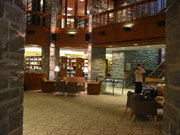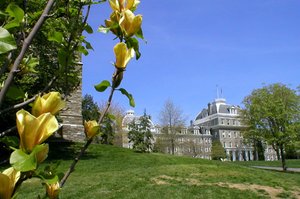Swarthmore College
|
|
Template:Infobox University2 Swarthmore College is a private, coeducational liberal arts college in the United States. It is highly selective and considered is one of the top liberal arts colleges. All of its 1,400 students are undergraduates. Swarthmore is located in the borough of Swarthmore, Pennsylvania, around 11 miles (17.7km) southwest of Philadelphia. The school was founded in 1864 by the Philadelphia Yearly Meeting of the Quakers. Swarthmore dropped its religious affiliation and became officially non-sectarian in the early 20th century. However, strong Quaker influences remain, including the tradition of holding "collections," a strong focus on the college as a community, and weekly Quaker services at the campus meetinghouse.
The pronounciation of Swarthmore is either as spelled or, more commonly, with a dropped 'r.' The student body is around 60 percent Caucasian, 15 percent Asian, 10 percent Hispanic, and 10 percent black. The school newspaper is the Phoenix (http://phoenix.swarthmore.edu/); the yearbook is the Halcyon. Only two fraternities are on campus, with around 5 percent participation. The most popular majors at Swarthmore are political science, English literature, and economics.
Swarthmore's sprawling suburban campus is often described as scenic. Much of the campus is home to the Scott Arboretum (http://www.scottarboretum.org/), explaining why most trees and shrubs at Swarthmore are labeled by genus and species.
| Contents [hide] |
Academics
Amphitheater.jpg
Swarthmore is consistently rated as one of the best liberal arts colleges in the country. In its most recent ranking, U.S. News & World Report ranked Swarthmore as the number two liberal arts college, with an overall score of 98/100 in its annual "America's Best Colleges" issue. (Swarthmore ranked behind Williams College and was tied with Amherst).
The school is particularly noted for its External Examiners Honors program, which allows students to take intense, double-credit seminars from their junior year and start writing honors theses without any immediate examination. At the end of their senior year, the honors students take oral and written examinations conducted by outside experts.
Unlike the vast majority of liberal arts colleges, the school has an engineering program (http://www.engin.swarthmore.edu/), recognized by the US News and World Report as one of the top undergraduate engineering programs in the United States. Other unique programs include the minors in Peace and Conflict Studies and Interpretation Theory.
Swarthmore is a member of the Tri-College consortium of liberal arts colleges, along with Bryn Mawr College and Haverford College. The consortium as a whole is additionally affiliated with the University of Pennsylvania.
History
The name 'Swarthmore' has its roots in early Quaker history. Swarthmoor Hall, in Cumbria, England, was the home of Thomas and Margeret Fell in 1652 when George Fox, fresh from his epiphany atop Pendle Hill in 1651, came to visit. The visitation turned into a long association as Fox persuaded Thomas and Margeret Fell and the inhabitants of the nearby village of Fenmore of Friendly, and Swarthmoor was used for the first Friends' meetings.
See also: Unofficial History of Swarthmore College (http://www.sccs.swarthmore.edu/users/98/elizw/Swat.history/)
Alumni
Swarthmore's alumni include five recipients of the MacArthur Foundation Fellowship (sometimes referred to as "the genius awards") and four Nobel laureates, most recently Edward C. Prescott of the class of 1962. In addition, hundreds of prominent figures–in diverse fields, including law, art, science, business, and politics –have attended Swarthmore. The most famous Swarthmore graduates are probably Michael Dukakis, a former Presidential candidate and novelist James Michener, both of whom graduated with highest honors. (Astronaut Sally Ride, the first American woman in space, attended but later transferred to Stanford University to major in Physics and English.)
Other notable Swarthmore alumni can be found on the List of Swarthmore College people
- Co-educational institution from its beginning (1864)
- Continuously highly ranked on U.S. News and World Report's ranking of liberal arts colleges
- Campus itself is a nationally recognized arboretum (see Scott Arboretum (http://www.scottarboretum.org/))
Clubs and organizations
There are 100 registered clubs and organizations at Swarthmore, in addition to many other unregistered groups. Among these are the honor societies: Phi Beta Kappa for general academia, Tau Beta Pi for engineering, and Sigma Xi for science. There are also several religious organizations on campus, including the Muslim Students Association, Swarthmore Christian Fellowship, Catholic Student Community, and the Swarthmore Protestant Community. There is also the Swarthmore Young Friends, a Quaker organization, and Ruach, a Jewish group associated with the Hillel Society.
There are several well known ethnic/cultural organizations. The most famous of these is the Swarthmore African American Students Society, formally the Swarthmore Afro-American Students Society. This organization, known as SASS, was deeply involved in the American Civil Rights Movement. Other notable organizations of the type include the Swarthmore Asian Association, the Swarthmore African Student Association (SASA), and Students of Caribbean Ancestry (SCA). In addition, there is DESHI (South Asian), Enlace (Latino), Multi (multicultural), and Pansori (Asian/Asian-American). Other cultural groups on campus include Swarthmore Queer Union, the International Club, Russian Cultural Club, Native American Student Organization (NASA), and ADVICE (a multicultural group; the name stands for "Advocating Diversity and Various Ideologies in a Campus Environment"). One of the College's most offbeat groups is the Swarthmore Warders of Imaginative Literature (SWIL), the sci-fi and fantasy club.
Swarthmore is also known as a center of social and political activism. Two groups, the Swarthmore Coalition for the Digital Commons, also known as the SCDC, and Why War? were involved in a 2003 lawsuit and civil disobedience campaign against Diebold in connection with flawed e-voting machines. In addition to the College Democrats and College Republicans, there is also a campus Amnesty International chapter, Students Against the Occupation, the Animal Rights Coalition, Swarthmore Voices for Choice, Conscious Consumers, and the Swarthmore Living Wage and Democracy Campaign. Other groups include the Queer-Straight Alliance, Earthlust (an environmentalist group), Feminist Majority, and the Swarthmore Political Action Committee. Swarthmore's political landscape is generally considered fairly left-wing.
There are several musical groups on campus. Music department sponsored ensembles include the College Orchestra (usually about 50 members), Chorus (usually around 80 members), Wind Ensemble, Gamelan, Jazz Band and the well-endowed Fetter Chamber Music Program, which provides coaching for many student quartets, trios and other small ensembles. The most notable student-run groups are Sixteen Feet (men's a cappella and the college's oldest) and Mixed Company (coed a cappella). Others include Oscar and Emily (jazz a cappella), Grapevine (women's a cappella), Sticks and Stones (coed a cappella), Chaverim (Tri-college coed Jewish a cappella), Cantatrix (sacred, medieval and renaissance music), and Essence of Soul (coed a cappella). There is also a Gospel Choir.
Campus media
The main student newspaper at Swarthmore is The Phoenix, a weekly school-sponsored newspaper published every Thursday, except during exam and vacation time. Staff positions are paid. The newspaper was founded in 1881, with online editions beginning in 1995. Its current format is more similar to a newsmagazine than a newspaper, with a color front cover. Two thousand copies, free of charge, are distributed across the college campus and to the Borough of Swarthmore. The newspaper is printed at The Delaware County Daily Times in Primos. Its online version's Web hosting by the Swarthmore College Computer Society, with bandwidth-search engine capability provided by the Swarthmore College Information Technology Services. In 2000, The Phoenix was an Online Pacemaker for the Associated College Press award.
The Daily Gazette is another student newspaper; unlike The Phoenix, it is a daily paper and is independent from the administration and student government. Its coverage includes news, arts, and daily sports reporting. The first issues were distributed through email during the fall semester of 1996, with an online edition soon following. Currently, the Daily Gazette has 1700 subscribers. The Agora is another small student newspaper with a liberal, activist outlook.
There are a number of magazines at Swarthmore, most of which are published biannually at the end of each semester. One is Spike, Swarthmore's humor magazine. The others are literary magazines, which include Small Craft Warnings, and Red Sky Night, both mainstream literary magazines, publishing poetry and short fiction, Scarlet Letters, which publishes women's literature, Enie, for Spanish literature, OURstory, for literature relating to diversity issues, Bug-Eyed Magazine, for science fiction and fantasy, CelebrASIAN, published by the Swarthmore Asian Organization (SAO), Alchemy, a collection of academic writings published by the Swarthmore Writing Associates, Mjumbe, published by the Swarthmore African-American Student Society (SASS), as well as a magazine for French literatue. The erotica magazine, Bang!mag, was rumored to have been revived in Spring 2005, but no copies have been publicly distributed, if printing occurred.
Most of the literary magazines print approximately 500 copies, with around 100 pages.
WSRN 91.5 FM is the college radio station.
See also
External links
- Swarthmore College (http://www.swarthmore.edu/)
- The Meaning of Swarthmore College (http://www.swarthmore.edu/news/meaning/)
- The Honors Program at Swarthmore College (http://www.swarthmore.edu/academics/honors/)
- The Phoenix (http://phoenix.swarthmore.edu/)
- Swarthmore College Computer Society (http://www.sccs.swarthmore.edu/)
- History of Swarthmoor Hall (http://www.swarthmoorhall.co.uk/history.htm)
- Would Shakespeare Get Into Swarthmore? (http://www.theatlantic.com/doc/200403/katzman), March 2004, The Atlantic Monthly
- The Meaning of Swarthmore (http://www.suddenlyorange.com/stream/swarthmore_full.ram)
- Swarthmore Unscripted (http://www.swarthmore.edu/unscripted/)
- Swarthmore College Commencement 2004 (http://www.suddenlyorange.com/stream/swarthmorecom2004.html)
- WSRN: Swarthmore College Radio (http://wsrn.swarthmore.edu/)


